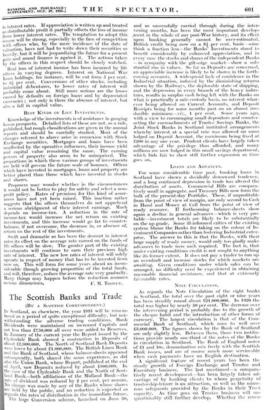BEST KINDS OF LIFE INVESTMENTS.
Knowledge of the investments is of assistance in gauging bonus prospects. Detailed lists of these are not, as a rule, published, but rough classifications are given in the annual reports and should be carefully studied. Most of the changes referred to above arise in connexion with Stock Exchange securities. Mortgages and loans have been unaffected by the operative influences, their income yield and capital value remaining the same. The earning powers of property also seem to be unimpaired. The proportions in which these various groups of investments are held will govern the future. scale of bonuses. Offices which have invested in mortgages, loans and property are better placed than those which have invested in stocks and shares.
Proposers may wonder whether in the eircuinstances it would not be better to play for safety and select a non- profit policy. Rates of premium for this kind of assur- ances have not yet been raised. This inaction rather suggests that the offices themselves do not apprehend a serious abridgment of their interest earnings. Much depends on income-tax.- A reduction in the rate of income-tax would increase the net return on existing investments, and this increase would go far to counter- balance, if not overcome, the decrease in, or absence of, return on the rest of the investments.
Swift and dramatic as has been the descent in interest rates its effect on the average rate earned on the funds of life offices will be slow. The greater part of the existing investments will continue to earn their previous high rate of interest. The new low rates of interest will solely operate in respect of money that has to be invested from now on. This will form for some years ahead an incon- siderable though growing proportion of the total funds, and will, therefore, reduce the average rate very gradually. Many things may happen before the reduction assumes












































 Previous page
Previous page